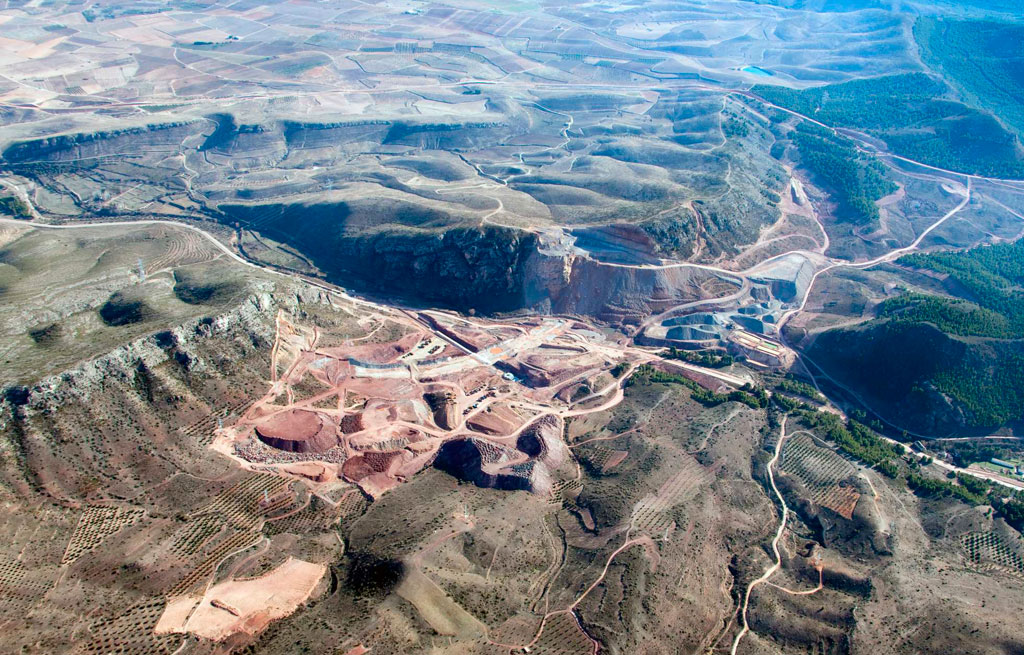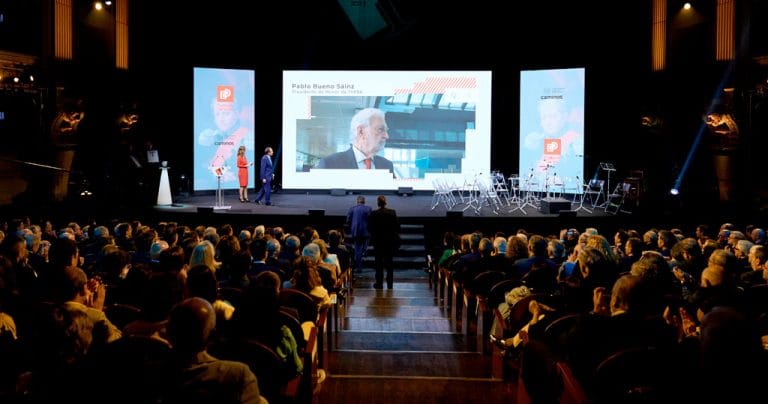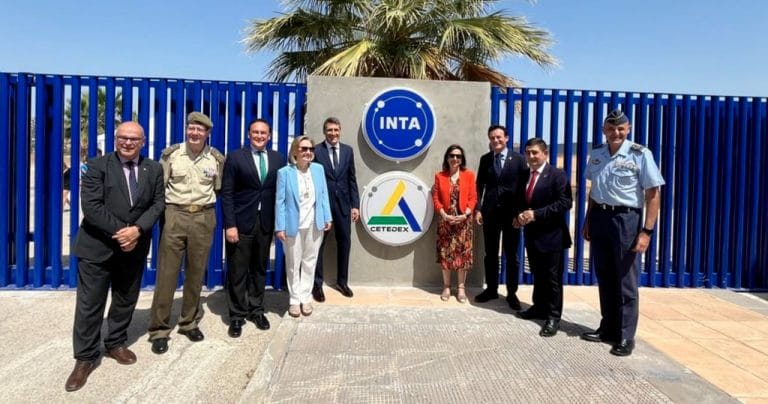On 13th March 2023, excavation of the second and final section of the Mularroya tunnel commenced from Paracuellos de la Ribera. The initial 8.2 km section of the tunnel was previously completed after a long and arduous underground journey, involving almost two years of intense work which had started on 24th November 2020 with the help of the “Creta” tunnel boring machine.
Prior to the start of the mechanized excavation, 61 m of conventional excavation had been completed using forepoling minipiles, TH-21 steel ribs, and shotcrete.
The tunnel will be a fundamental element of the Mularroya hydraulic complex, which includes an earthfill dam capable of storing and regulating a reservoir with a capacity of over 103 hm3.
Hydraulic schematic of Mularroya
The main elements of the project are the already-completed Mularroya dam, the bypass dam and the transfer tunnel.
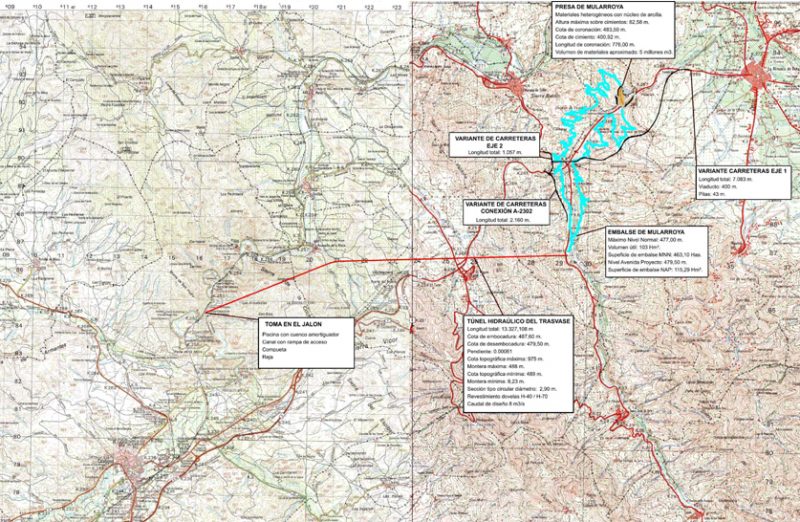
General schematic plan of the intervention
For the construction of the 82.5m high Mularroya dam, 4.7 million m3 of loose compacted materials have been used. The dam body itself has a vertical central core of clay, slats of granular material (transition material) and limestone burlap in both walls.
The bypass blade is 23.5 m high.
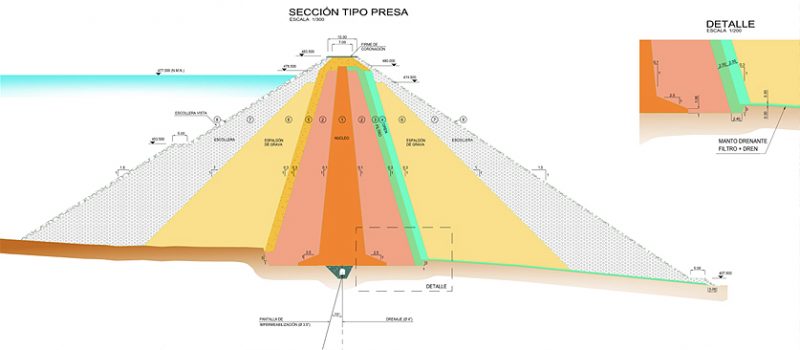
Typical cross section of the dam (maximum height over foundations 82.5 m)
With a total length of 12.6 km, the Mularroya tunnel is one of the most unique hydraulic works carried out in Spain in recent decades, and a reference for hydraulic tunnels under construction in Europe at this time. Its purpose will be to transport surplus water from the Jalón River to the Grío River basin, thereby maximizing the use of the area’s water resources for irrigation.
The tunnel passes through the municipalities of Calatayud, Paracuellos de la Ribera, El Frasno, and Morata de Jalón. With a free inner diameter of 2.9 m and an exterior excavation of 3.5 m, it will have a transfer capacity of up to 8 m3 of water per second.
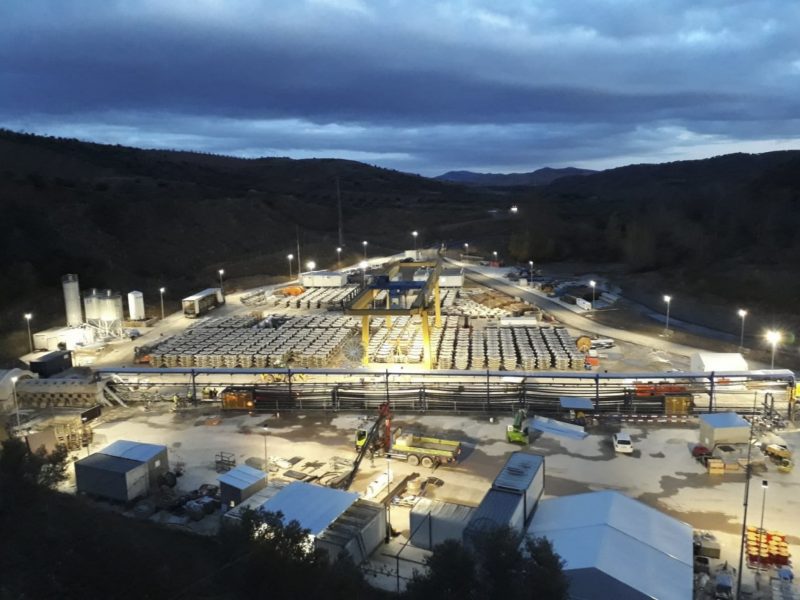
General view of the facilities on the River Grío
| Start CH |
12+654,6 |
| Final CH |
4+429 |
| Completed length (m) |
8.217,6 |
| Number of rings installed |
6848 |
| Average progress (m/day) |
13,11 |
| Average progress (rings/day) |
10,92 |
| Percentage of tunnel completion (%) |
64,94 |
Summary of section 1 of the Mularroya tunnel, the origin is in the Jalón River
Geology
Materials dated from different geological eras were identified throughout the excavation as follows:
- Zone 1: P.K. 0+000 to 3+950: Cambrian
- Zone 2: P.K. 3+950 to 5+500: Precambrian
- Zone 3: P.K. 5+500 to 7+300: Cambrian
- Zone 4: P.K. 7+700 to 9+400: Buntsandstein
- Zone 5: P.K. 9+400 to 12+600: Ordovician
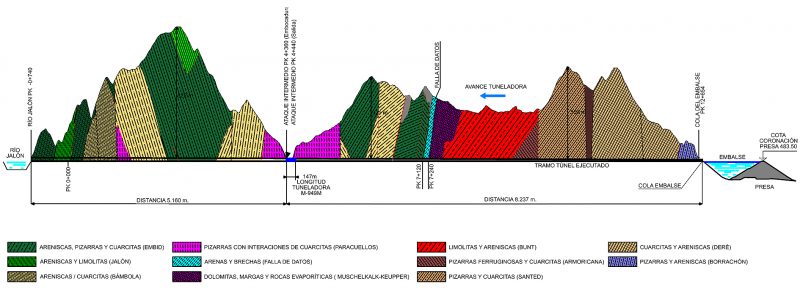
Geological longitudinal profile along the route
The information provided by the telemetry of the TBM, inspection of the cutting wheel (openings that allow material visibility in situ), together with the information obtained from the detritus of the excavation (description of visu, identification laboratory tests, Los Angeles Wear (DLA) and petrographic), in addition to the detailed geological reconnaissance on the surface of the tunnel trace, has made it possible to detect changes in the initial geological interpretation of the project, at tunnel level.
These changes are directly related to the geological and geomechanical properties of the different units and to their permeability.
In addition to these tectonic accidents detected on the surface, together with the project surveys, it has been possible to detect new tectonic accidents (faults and tectonized zones) in the sections already drilled yet not detected in the project, either due to lack of accessibility, or because they are not visible on the surface.
During the construction phase, significant variations have been identified and, in particular, a considerable increase in faults and tectonized sections with respect to the project specifications. Initially, there were plans to address 12 faults, which covered approximately 200 m of weak areas. However, upon further inspection, a total of 45 faults were recorded, with significantly longer sections of weakness and high levels of fracturing, totaling approximately 900 m in length. These sections have presented weakness and sections with intense fracturing (small spacing and great continuity), which favors a greater development of permeability.
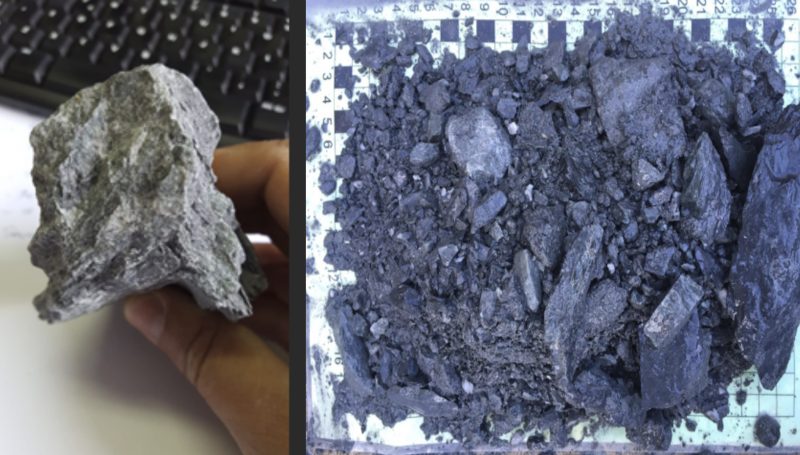
Identification of materials at the face and on the conveyor belt
The ring
The sizing of the lining has been made for a straight layout, with a configuration of 6 + 0 segments. The ring has an A1 base segment with the ability to fix rails in readiness for the construction phase of the tunnel. The length of the ring is 1.2 m with a thickness of 20 cm.
The concretes used have characteristic strengths of 40, 50 and 70 MPa for segments with varying capacities. As for the shape of the contacts between rings, these have been developed, both in radial and circumferential joints, with a flat joint design. Furthermore, the radial flat joint houses a guide bar. The tightness in the joints is achieved with a recessed rubber seal of polyethylene propylene diene monomer (EPDM), capable of withstanding pressure equivalent to that of 240 m of water.
The tunnel-boring machine
“Creta”, the machine used for tunnel construction is the Herrenknetch model M-949-M, with an external diameter of 3.55 m and equipped with 12 thrust cylinders. In addition to the shield body itself of 9.65 m in length, between the cutting wheel and the tail shield, the composition of the 16 back-up wagons reaches a total length of 140 m.
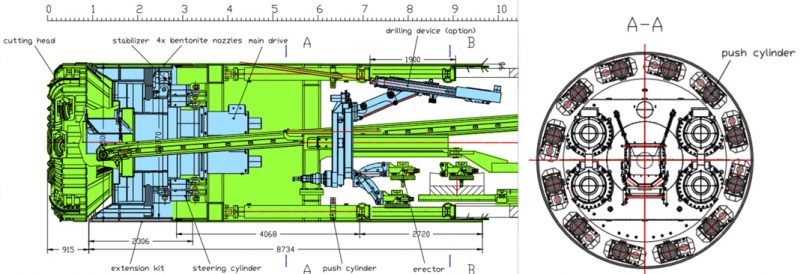
TBM shield and section with thrust cylinders
The cutting wheel is equipped with 17” diameter discs and the system provides a nominal thrust of 17,000 kN (exceptionally 21,000 KN) and an unlocking torque of 2000 kN/m.
One of the key aspects has been the ability of a small machine to cope with the significant thrusts necessary during the advance, the thrust power and the release torque of the machine.
In the case of Mularroya, both the possibility of turning the cutting wheel (RDC) in both directions, and the provision of sensors and equipment to analyze the advance of the face, have been fundamental.
The excavated material has been extracted through a continuous conveyor belt with a transport capacity of 150 t/h.
The TBM is equipped with an instrumentation system that generates a large amount of real-time data via fiber optics. The proper understanding and management of this data is essential for the progress of the project and informed decision-making.
All types of parameters are monitored by the installed sensors. These include, among many others, the pump pressures of components A and B of the injection mixture of the gap (annular space between the TBM and the excavated ground), the pressure of the tail shield grease, pressures and displacements in the jacks and hydraulic systems, power and current parameters of the electrical systems, flows, volumes, weights, and all kinds of variable data over time.
During the first phase, the information is recorded in the TBM control cabinet control unit, which has a control system for steering, feeding, digging and sludge operations called Program Logic Controller (PLC), and the programmed monitoring parameters are displayed on different screens.
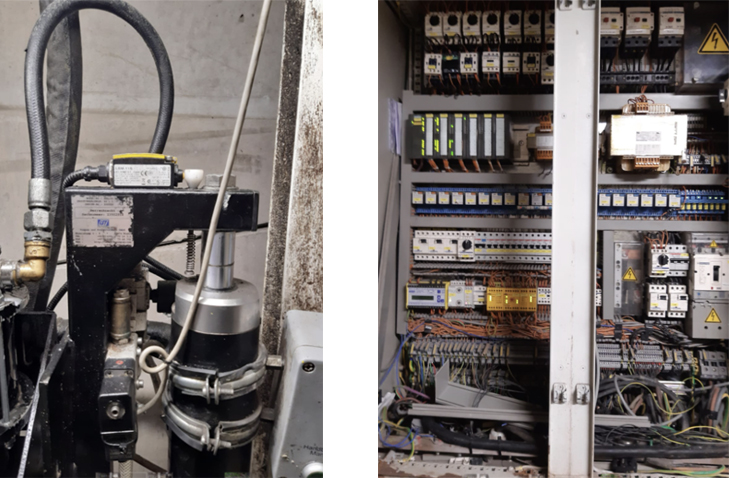
Sensors and controllers at the Mularroya TBM
A sophisticated computer application processes this information generating graphs showing the correlation between different variables and analyzing their evolution over time. Depending on the evolution of the advance, interconnected information can be obtained, advance by advance, centimeter by centimeter, ring by ring.
More than 1,000 sensors installed at multiple points and devices of the TBM record information that is sent through a fiber optic cable to an external server. A computer application then selects 100 necessary parameters to monitor in greater detail. In this case, the variables of greatest interest are the following:
- Penetration speed
- Speed of rotation of the cutting disc
- Torque and thrust force, total and per jack
- Guidance to maintain the topographic direction of the machine
- Pressures in the cylinders and pumps of the two-component mixture
- Pressures and volume of tail grease
- Gases and hazardous airborne particles
- Temperature in motors and drives
- Electrical parameters, power, intensity and consumption.
Video of the tunnel construction.
Challenges during excavation
It should be noted that due to poor ground conditions, particularly in the “Datos” fault, with appreciable creep phenomena, and significant filtration flows in the face, serious entrapments of the shield armor occasionally occurred. In order to unblock the TMB, the installation of additional thrust cylinders and special reaction rings were needed, to provide additional and much higher thrust than the initial nominal thrust of the machine.
Additionally, in numerous sections, it has been necessary to stabilize the face through two-component polyurethane resin treatments.
The aforementioned was carried out in extremely difficult conditions due to the reduced dimensions of a 2.9m circular space, combined with the machine itself and the power supply, pumping and ventilation systems.
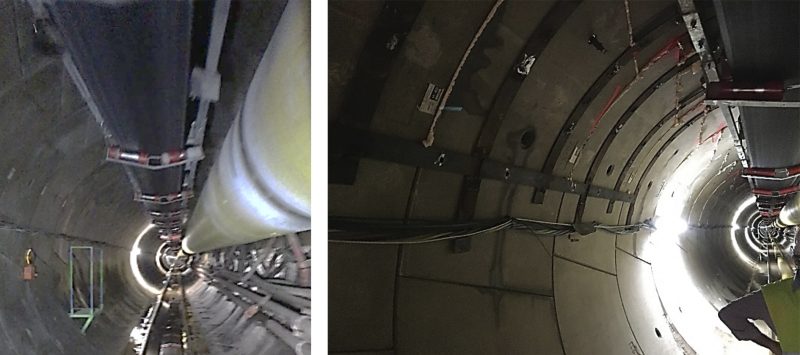
Interior of the Mularroya tunnel with the hidden debris removal conveyor, ventilation pipe and shelters for descent and inspections, and provisional reinforcements
Environmental control
Environmental control and monitoring of the works have been conducted based on the environmental resolution of the project and subsequent instructions issued by the environmental authority. This has involved the implementation of various corrective and protective measures, including, among others, the installation of water treatment plants to treat water drained by the tunnel before discharging it into the Grío River and the installation of auxiliary wells for irrigation.
The second stretch
The remaining 4.4 km of excavation, which began on 13th March 13, 2023, has shown a higher-than-average rate of progress than in the first section, due to the learning curve acquired during the initial phase. Consequently, it is expected that the tunnel construction will be completed in under 10 months.
It is expected that the significant lessons learned together with the experience gained during the execution of the first 8.2 km, will enable the completion of the project for its upcoming commissioning.
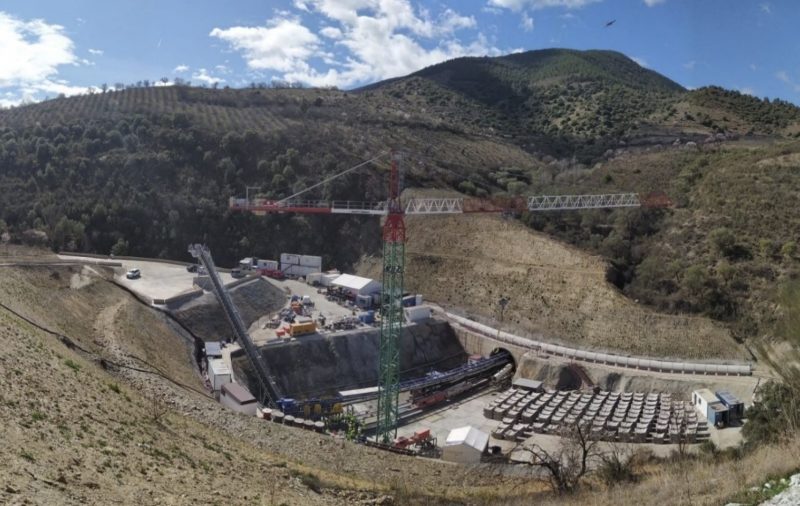
General view of the Paracuellos facilities. Start of the second section


